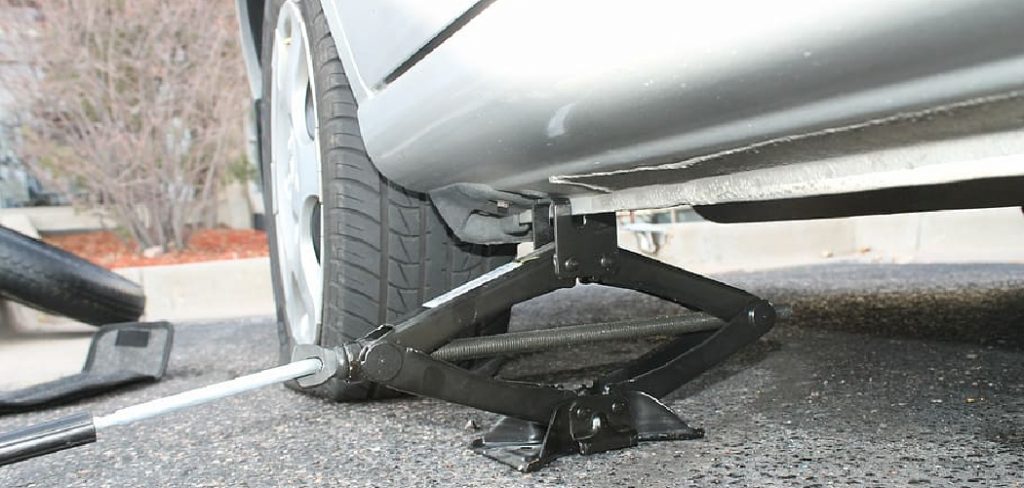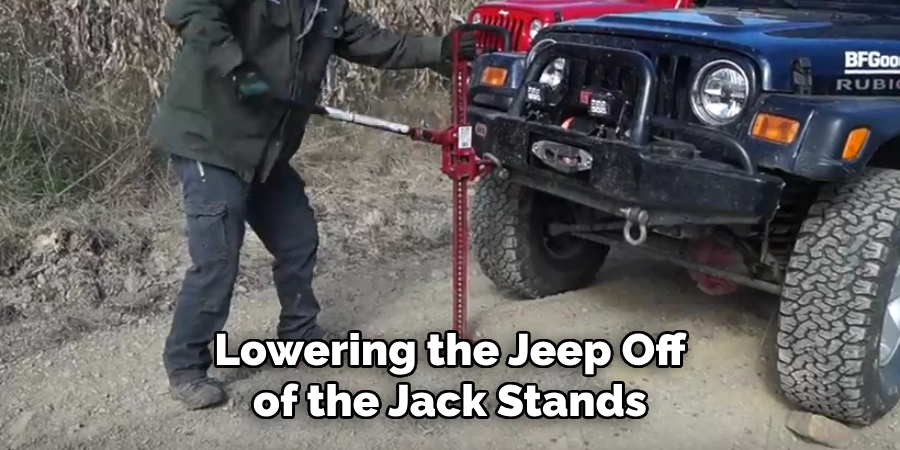Attention all Jeep Wrangler enthusiasts! Whether you are a seasoned off-roader or just a proud owner of this iconic vehicle, there is no denying the popularity and versatility of the Jeep Wrangler. From its rugged design to its exceptional performance on all types of terrain, it’s no wonder that so many people love their Jeeps.

However, as with any vehicle, maintenance and repairs are essential for keeping your Jeep in top shape. One crucial skill that every Jeep owner should have is knowing how to properly jack up their vehicle.
In this blog post, we will be diving into the step-by-step process of how to jack up a Jeep Wrangler safely and efficiently. So grab your tools and get ready to learn how to elevate your off-road game!
Why is It Important to Jack Up a Jeep Wrangler?
Before we dive into the nitty-gritty of jacking up a Jeep, let’s first understand why it’s essential. There are various reasons why you may need to jack up your vehicle, such as changing a tire, performing maintenance or repairs, or simply inspecting the underside of your Jeep. Jacking up your Jeep properly ensures that you have a stable and safe working environment, preventing any accidents or injuries.
It also allows for easier access to certain components of the vehicle, making maintenance tasks more manageable. Now that we understand the importance let’s get into the steps of jacking up a Jeep Wrangler.
Tools and Materials You Will Need to Jack Up a Jeep Wrangler
- A high-quality jack (preferably a hydraulic or bottle jack)
- Jack stands
- Wheel chocks
- A lug wrench or impact wrench
- Gloves
- Protective eyewear
Step-by-step Guidelines on How to Jack Up a Jeep Wrangler
Step 1: Find a Safe and Level Surface

Before beginning the jacking process, it is crucial to find a flat and stable surface to park your Jeep. Avoid any inclines or uneven surfaces that may cause the vehicle to roll or slip off the jack stands. This step is vital for your safety and the stability of the vehicle. If you are on the side of the road, be sure to turn on your hazard lights and use warning signs to alert other drivers.
Step 2: Prepare Your Jeep
Once you have found a suitable surface, it’s time to prepare your Jeep for jacking. Turn off the engine, engage the parking brake, and remove any loose objects from inside the vehicle. This will prevent any accidents or damage during the jacking process. Preparing your Jeep also includes loosening the lug nuts on the wheels you are planning to lift. This will make it easier to remove them later.
Step 3: Place Wheel Chocks
Wheel chocks are essential for preventing any movement of the vehicle while jacking. Place them behind the opposite wheels of the ones you plan to lift. For example, if you are lifting the front wheels, place the chocks behind the rear wheels. This will ensure that your Jeep stays in place while you work on it. While it is not necessary, you can also use bricks or rocks in place of wheelchocks.
Step 4: Position Jack Underneath the Vehicle
Using your jack, lift the Jeep at the designated jacking points. These are usually marked with an arrow on the frame of the vehicle. If you are unsure about where to place your jack, refer to your owner’s manual for guidance. Ensure that the jack is securely positioned before lifting the vehicle. Make sure to avoid any plastic parts or the axles when positioning the jack.
Step 5: Place Jack Stands

Once the Jeep is lifted, it’s time to place the jack stands under the designated support points. These are usually located near the jacking points and are designed to hold the weight of the vehicle. Slowly lower your Jeep onto the jack stands and double-check that they are securely in place. While it is not necessary, you can also place a block of wood between the jack stand and the vehicle for added stability.
Step 6: Remove Wheels
Now that your Jeep is securely lifted and supported by the jack stands, it’s time to remove the wheels. Use your lug wrench or impact wrench to take off the lug nuts and carefully remove the wheel from the vehicle. Place the wheel under the Jeep as an extra precaution in case it were to fall off the jack stands.
Step 7: Complete Maintenance or Repairs
With your Jeep safely elevated, you now have easy access to perform any maintenance or repairs needed. Whether it’s changing a tire, inspecting the brakes, or replacing suspension components, jacking up your Jeep provides a stable and safe working environment for you to complete these tasks. Make sure to follow proper safety precautions and use your gloves and protective eyewear while working on the vehicle.
Step 8: Lower Your Jeep
Once you have completed your maintenance or repairs, it’s time to lower your Jeep back onto the ground. Simply reverse the process by placing the wheel back onto the vehicle, tightening the lug nuts, and gently lowering the Jeep off of the jack stands. Remove the jack stands and wheel chocks, and you’re all done!

Following these steps will ensure that you safely and efficiently jack up your Jeep Wrangler. Remember to always double-check that the vehicle is securely lifted before starting any work, and never get underneath the vehicle while it is only supported by a jack. With this knowledge, you can confidently tackle any maintenance or repairs needed on your beloved Jeep Wrangler. Happy off-roading!
Additional Tips and Tricks to Jack Up a Jeep Wrangler
- If you are planning on lifting your Jeep Wrangler, it’s important to consider the weight and size of your tires. The larger and heavier your tires, the more strain it will put on your vehicle when jacked up.
- It’s also important to use proper jacking points on your Jeep Wrangler. These are designated areas on the frame where it is safe to place a jack. Using other areas could cause damage to your vehicle.
- Before jacking up your Jeep, make sure the emergency brake is engaged and the vehicle is in park. This will prevent it from rolling while lifted.
- It’s always a good idea to have someone assist you when jacking up your Jeep Wrangler. They can help guide the placement of the jack and keep an eye out for any potential safety hazards.
- When using a hydraulic floor jack, make sure it is positioned on a flat and stable surface. Using it on uneven ground could cause the vehicle to shift and potentially fall off the jack.
- It’s important to regularly inspect your jack before each use. Look for any signs of wear or damage that could compromise its stability and safety.
- To prevent damage to your Jeep’s undercarriage, place a piece of wood or rubber between the jack and the designated jacking point.
- Always make sure the jack is securely in place before raising the vehicle. Once lifted, double-check for any movement or shifting.
- When lowering your Jeep back down, do so slowly and carefully. Sudden drops can cause the vehicle to shift or fall off the jack.
- Always have a set of wheel chocks on hand to place behind the tires that are still on the ground. This will provide an extra level of safety in case the vehicle starts to roll.

Following these tips and tricks will ensure a safe and successful jacking up of your Jeep Wrangler, allowing you to confidently tackle any off-road adventures. Remember to always prioritize safety and double-check all equipment before proceeding with lifting your vehicle. Happy wheeling!
Frequently Asked Questions
How Do I Choose the Right Jack for My Jeep Wrangler?
It is important to choose the right jack for your Jeep Wrangler to safely and effectively lift your vehicle. Make sure to select a jack with a weight capacity that exceeds the weight of your vehicle. Also, consider the type of jack that will work best for your needs – a bottle jack, scissor jack, or floor jack are all suitable options. It is also recommended to purchase a set of wheel chocks to prevent your vehicle from rolling while being lifted.
How Do I Safely Jack Up My Jeep Wrangler?
Before jacking up your Jeep Wrangler, make sure you are on a level and solid surface. Turn off the engine and engage the emergency brake. Place wheel chocks around one of the wheels that will remain on the ground. Position your jack under a sturdy lift point, such as the frame or axle, and slowly raise the vehicle until it is high enough to work on safely.
Can I Use a Regular Car Jack for My Jeep Wrangler?
No, it is not recommended to use a regular car jack for your Jeep Wrangler. This type of jack may not have enough weight capacity or strength to properly lift your vehicle. It is better to invest in a quality, heavy-duty jack specifically designed for off-road vehicles like the Jeep Wrangler.
How Often Should I Check My Jack for Wear and Tear?
It is important to regularly check your jack for any signs of wear and tear, especially if you use it frequently. Look for cracks, rust, or other damage that can compromise the stability and safety of your jack. Also, make sure to follow the manufacturer’s recommended maintenance schedule to keep your jack in good working condition.
Conclusion
Now you know how to jack up a Jeep Wrangler safely and effectively. Remember to always choose the right jack for your vehicle, use proper lifting techniques, and regularly check for any issues with your jack. With these tips in mind, you can confidently lift your Jeep Wrangler whenever needed for maintenance or repairs. Happy off-roading!

About
JeepFixes Team is a skilled author for Jeep Fixes, bringing 6 years of expertise in crafting a wide range of jeep fixes. With a strong background in jeep fixes work, JeepFixes Team’s knowledge spans various types of fixtures, from decorative pieces to functional hardware, blending precision with creativity. His passion for jeep fixes and design has made him a trusted resource in the industry.
Professional Focus:
Expert in Jeep Fixes : JeepFixes Team aesthetic specializes in creating durable and innovative jeep fixes, offering both appeal and functionality. His work reflects a deep understanding of jeep fixes techniques and materials.
Sustainability Advocate : He is dedicated to using sustainable practices, ensuring that every fixture is crafted with eco-friendly methods while maintaining high-quality standards.
In his writing for jeep fixes, JeepFixes Team provides valuable insights into the latest trends, techniques, and practical advice for those passionate about jeep fixes, whether they are professionals or DIY enthusiasts. His focus on combining artistry with engineering helps others discover the true potential of jeep in design.
